Geochemical Anomaly Characteristics of Cd in Soils around Abandoned Lime Mines: Evidence from Multiple Technical Methods
Abstract
:1. Introduction
2. Materials and Methods
2.1. Sample Collection
2.2. Sample Preparation
2.3. Analytical Method
2.3.1. XRD Measurement
2.3.2. XRF Measurement
2.3.3. SEM Observation
2.3.4. ICP-MS Analysis
2.3.5. Potential Ecological Risk Assessment
3. Result and Discussion
3.1. Determination of Background Values of Two Types of Soil Parent Materials
3.2. Mineral Composition of Two Types of Soil Parent Materials
3.3. Microstructure of Two Types of Soil Parent Materials
3.4. Spatial Distribution of Cd in Two Soil Parent Materials
3.5. Potential Ecological Risk Assessment of Cd in Two Soil Parent Materials
4. Conclusions
Author Contributions
Funding
Institutional Review Board Statement
Informed Consent Statement
Data Availability Statement
Conflicts of Interest
References
- Chaney, R.L.; Ryan, J.A.; Li, Y.M.; Brown, S.L. Soil cadmium as a threat to human health. Cadmium Soils Plants 1999, 85, 219–256. [Google Scholar]
- Zhang, J.; Chen, Z.; Zhong, S. Metal (loid)s pollution characteristics and ecotoxicity evaluation in soil nearby a silver smelting yard. Environ. Earth Sci. 2019, 78, 86. [Google Scholar] [CrossRef]
- Chen, Y.; Yuan, L.; Xu, C. Accumulation behavior of toxic elements in the soil and plant from Xinzhuangzi reclaimed mining areas, China. Environ. Earth Sci. 2017, 76, 226. [Google Scholar] [CrossRef]
- Wushuang, X.; Chi, P.; Hongtao, W. Bioaccessibility and source identification of heavy metals in agricultural soils contaminated by mining activities. Environ. Earth Sci. 2018, 77, 606. [Google Scholar]
- Li, M.; Mohamed, I.; Raleve, D. Field evaluation of intensive compost application on Cd fractionation and phytoavailability in a mining-contaminated soil. Environ. Geochem. Health 2016, 38, 1193–1201. [Google Scholar] [CrossRef]
- Wei, L.; Liu, G.; Wu, D. Characteristics and provenance of hazardous trace elements in soil from a typical agricultural region in eastern Anhui, China. Geosci. J. 2020, 24, 575–584. [Google Scholar] [CrossRef]
- Li, C.; Li, F.; Wu, Z. Effects of landscape heterogeneity on the elevated trace metal concentrations in agricultural soils at multiple scales in the Pearl River Delta, South China. Environ. Pollut. 2015, 206, 264–274. [Google Scholar] [CrossRef]
- Maas, S.; Scheifler, R.; Benslama, M. Spatial distribution of heavy metal concentrations in urban, suburban and agricultural soils in a Mediterranean city of Algeria. Environ. Pollut. 2010, 158, 2294–2301. [Google Scholar] [CrossRef]
- Mcgrth, D.; Zhang, C.; Carton, O.T. Geostatistical analyses and hazard assessment on soil lead in Silvermines area, Ireland. Environ. Pollut. 2004, 127, 239–248. [Google Scholar] [CrossRef]
- Rodríguez-Martin, J.A.; Lopez-Arias, M.; Grau-corbí, J.M. Heavy metals concentrations in agricultural topsoils in the Ebro basin (Spain): Application of the multivariate geostatisticalmethods to study spatial variations. Environ. Pollut. 2006, 144, 1001–1012. [Google Scholar] [CrossRef]
- Wang, Z.; Pang, Z.; Guo, Q. Introducing a land-use-based spatial analysis method for human health risk evaluation of soil heavy metals. Environ. Earth Sci. 2013, 70, 3225–3235. [Google Scholar] [CrossRef]
- Dong, J.; Yu, M.; Bian, Z. The safety study of heavy metal pollution in wheat planted in reclaimed soil of mining areas in Xuzhou, China. Environ. Earth Sci. 2012, 66, 673–682. [Google Scholar] [CrossRef]
- Hakanson, L. An ecological risk index for aquaic pollution con-trol-Asedimento logical approach. Water Res. 1980, 14, 975–978. [Google Scholar] [CrossRef]
- Wang, J.; Jiang, Y.; Sun, J. Geochemical transfer of cadmium in river sediments near a lead-zinc smelter. Ecotoxicol. Environ. Saf. 2020, 196, 110529. [Google Scholar] [CrossRef]
- Khan, M.; Islam, M.; Salam, A.B.A. Spatial variability and geostatistical analysis of soil properties in the diversified cropping regions of Bangladesh using geographic information system techniques. Appl. Environ. Soil Sci. 2021, 2021, 6639180. [Google Scholar] [CrossRef]
- Hawkes, H.E.; Webb, J.S. Geochemistry in mineral exploration. Soil Sci. 1963, 95, 283. [Google Scholar] [CrossRef]
- Levinson, A.A. Introduction to Exploration Geochemistry, 2nd ed.; Applied Publishing Ltd.: Wilmette, IL, USA, 1980; pp. 1–924. [Google Scholar]
- Gaillardet, J.; Calmels, D.; Romero-Mujalli, G. Global climate control on carbonate weathering intensity. Chem. Geol. 2019, 527, 118762. [Google Scholar] [CrossRef]
- Yang, G.; Li, H.; Cheng, D.B. Effect soft measurement model of steel slag powder repair heavy metal contaminated soil with fourier transform infrared spectrum. Spectrosc. Spectr. Anal. 2017, 37, 743–748. [Google Scholar]
- Rashad, A.M. Investigation on high-volume fly ash pastes modified with micro-size metakaolin subjected to high temperatures. J. Cent. South Univ. 2020, 27, 231–241. [Google Scholar] [CrossRef]
- Qiu, M.; Li, T.; Gao, X. Effects of urbanization on Cd accumulation in agricultural soils: From the perspective of accessibility gradient. Sci. Total Environ. 2020, 701, 134799. [Google Scholar] [CrossRef]
- Adamu, C.I.; Nganje, T.N.; Edet, A. Major and trace elements pollution of sediments associated with Abandoned Barite Mines in parts of Oban Massif and Mamfe Embayment, S.E. Nigeria. J. Geochem. Explor. 2015, 151, 17–33. [Google Scholar] [CrossRef]
- Rufino, M.M.; Albouy, C.; Brind’Amour, A. Which spatial interpolators I should use? A case study applying to marine species. Ecol. Model. 2021, 449, 109501. [Google Scholar] [CrossRef]
- Wu, D.; Wang, M.C.; Hu, G. Spatial distribution and environmental assessment of heavy metals in surface soil and ash near industrial sites: A case study. Energy Sources Part A Recovery Util. Environ. Eff. 2021, 1–12. [Google Scholar] [CrossRef]
- Tarnawczyk, M.; Uzarowicz, Ł.; Perkowska-Pióro, K. Effect of land reclamation on soil properties, mineralogy and trace-element distribution and availability: The example of technosols developed on the tailing disposal site of an abandoned Zn and Pb mine. Minerals 2021, 11, 559. [Google Scholar] [CrossRef]
- Loredo-Portales, R.; Bustamante-Arce, J.; González-Villa, H.N. Mobility and accessibility of Zn, Pb, and As in abandoned mine tailings of northwestern Mexico. Environ. Sci. Pollut. Res. 2020, 27, 26605–26620. [Google Scholar] [CrossRef] [PubMed]
- Fural, Ş.; Kükrer, S.; Cürebal, İ. Spatial distribution, environmental risk assessment, and source identification of potentially toxic metals in Atikhisar dam, Turkey. Environ. Monit. Assess. 2021, 193, 1–16. [Google Scholar] [CrossRef]
- Aiman, U.; Mahmood, A.; Waheed, S. Enrichment, geo-accumulation and risk surveillance of toxic metals for different environmental compartments from Mehmood Booti dumping site, Lahore city, Pakistan. Chemosphere 2016, 144, 2229–2237. [Google Scholar] [CrossRef]
- Hu, Z.; Fu, Y.; Xiao, W. Ecological restoration plan for abandoned underground coal mine site in Eastern China. Int. J. Min. Reclam. Environ. 2014, 29, 316–330. [Google Scholar] [CrossRef]
- Rassaei, F.; Hoodaji, M.; Abtahi, S.A. Cadmium speciation as influenced by soil water content and zinc and the studies of kinetic modeling in two soils textural classes. Int. Soil Water Conserv. Res. 2020, 8, 286–294. [Google Scholar] [CrossRef]
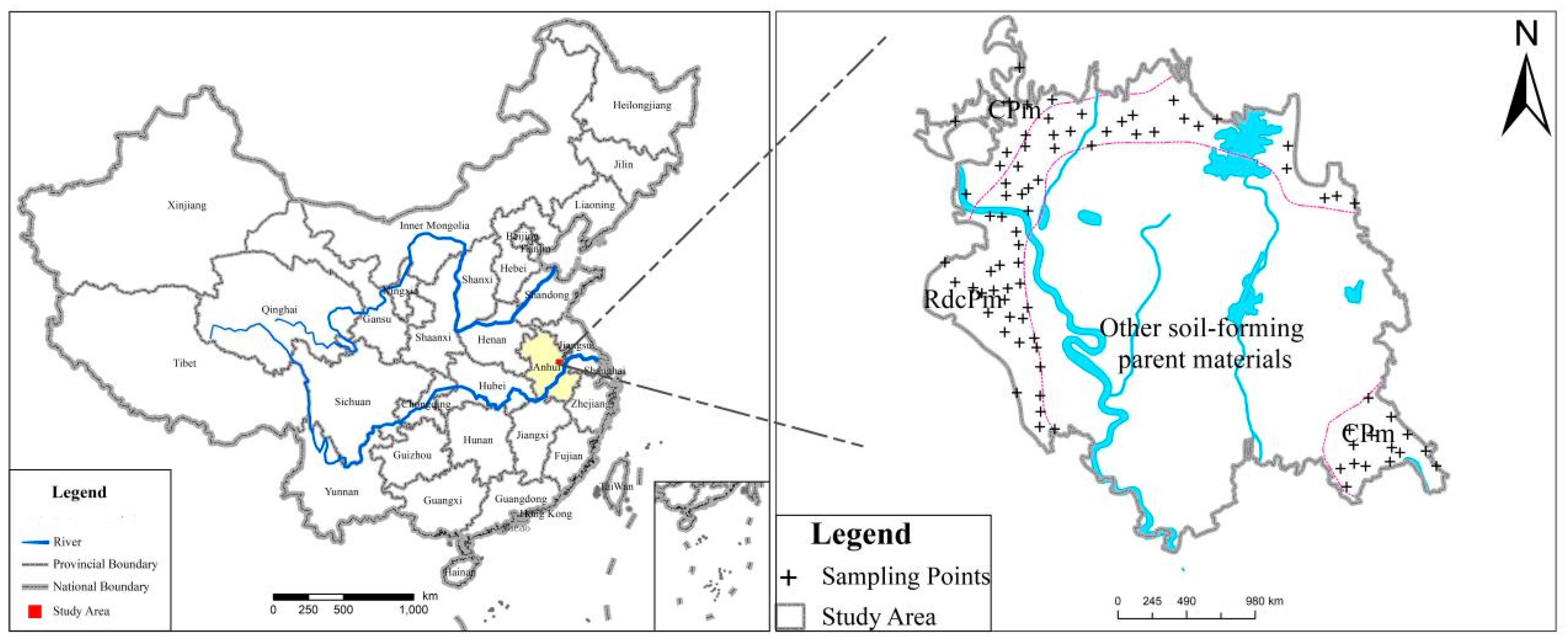

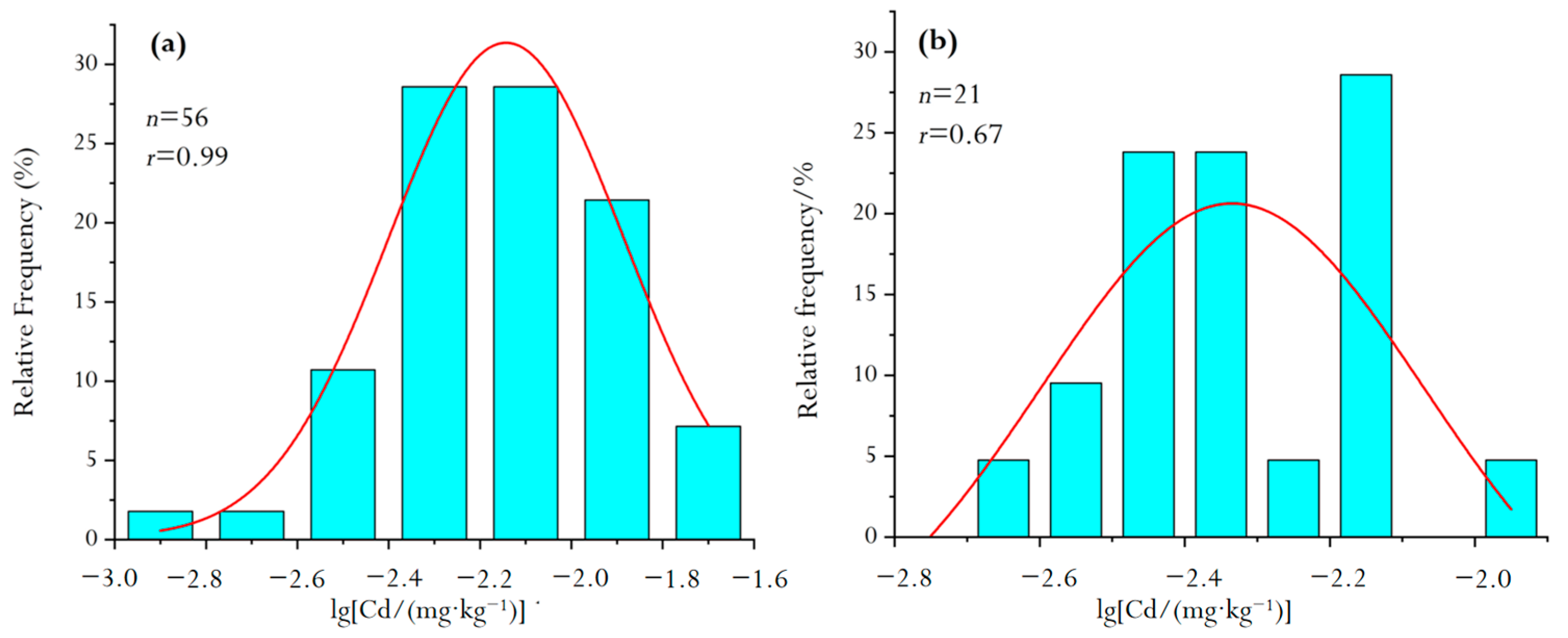
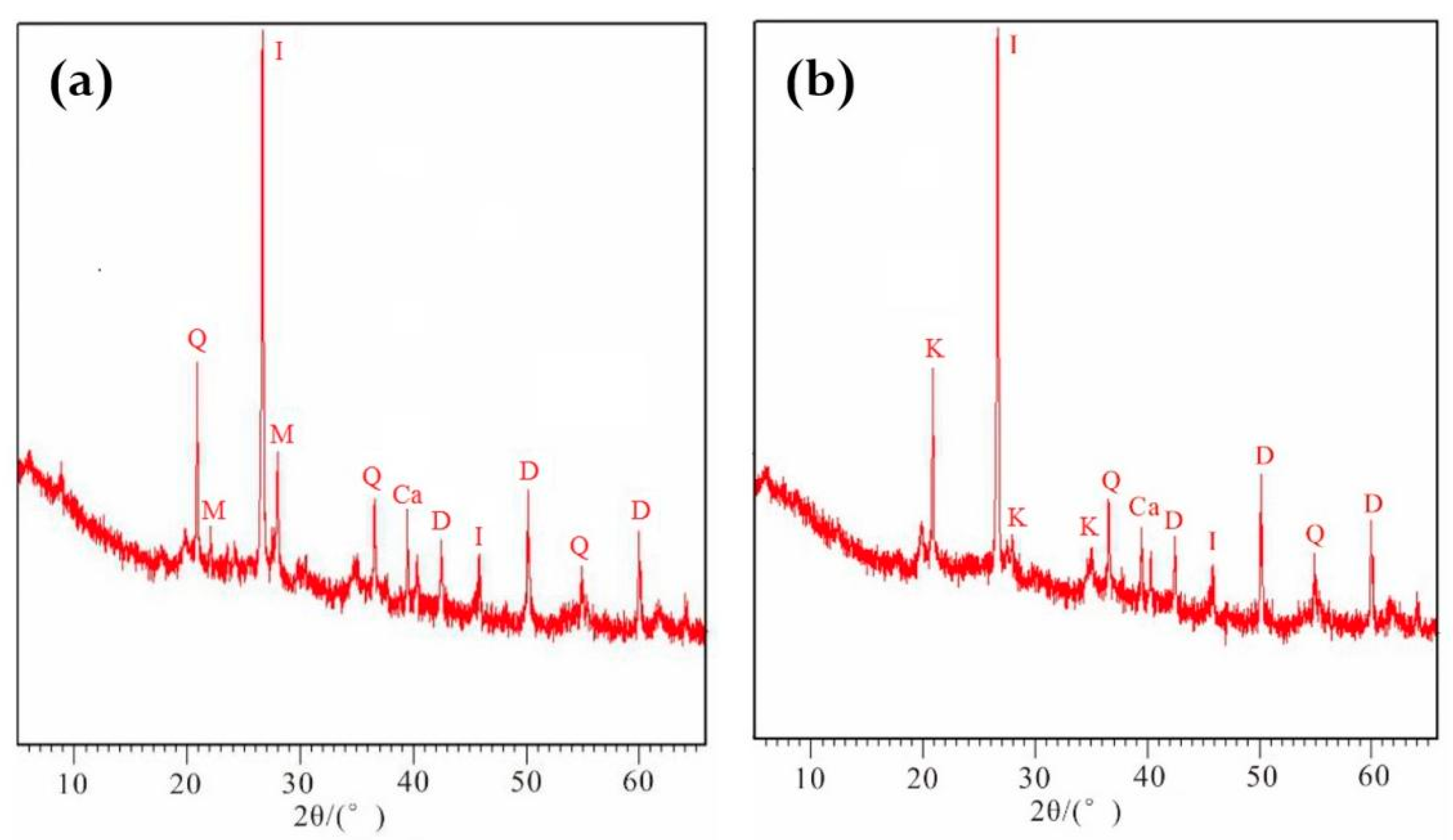
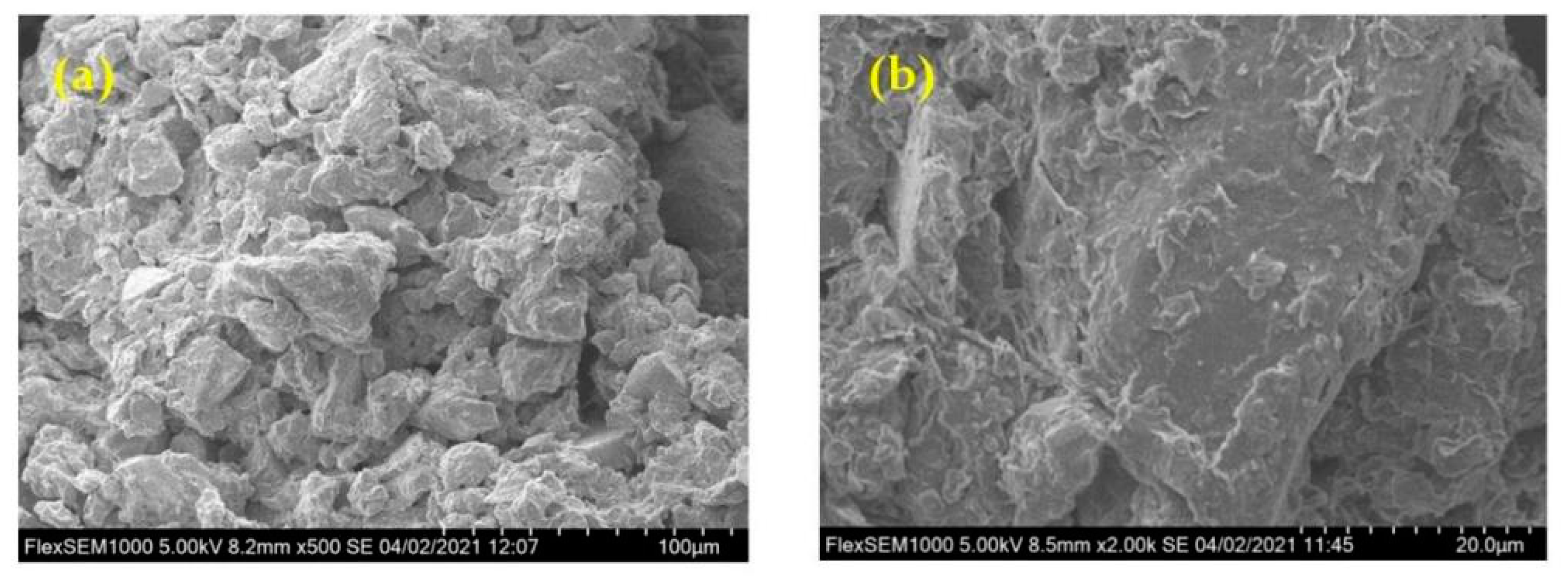
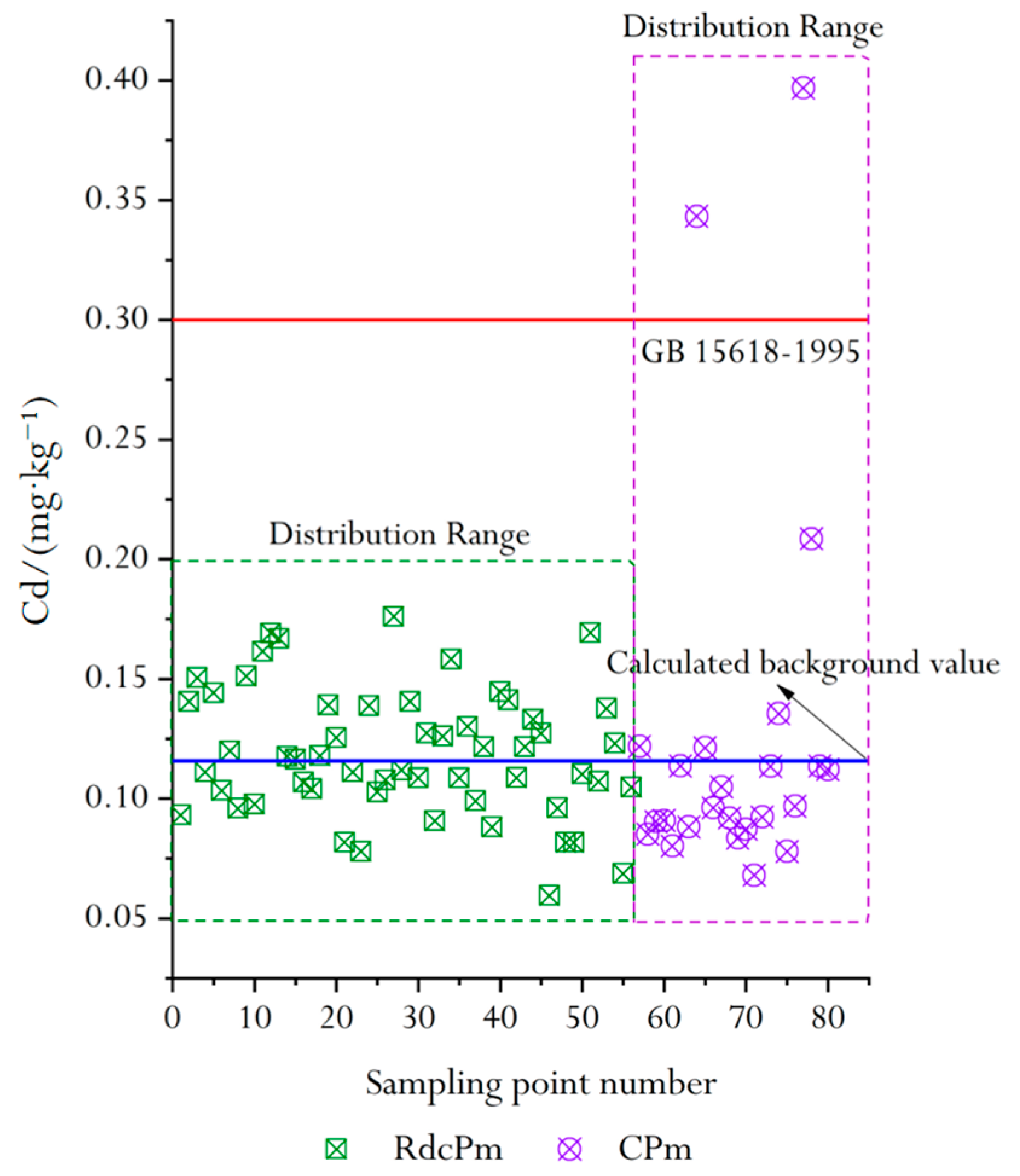
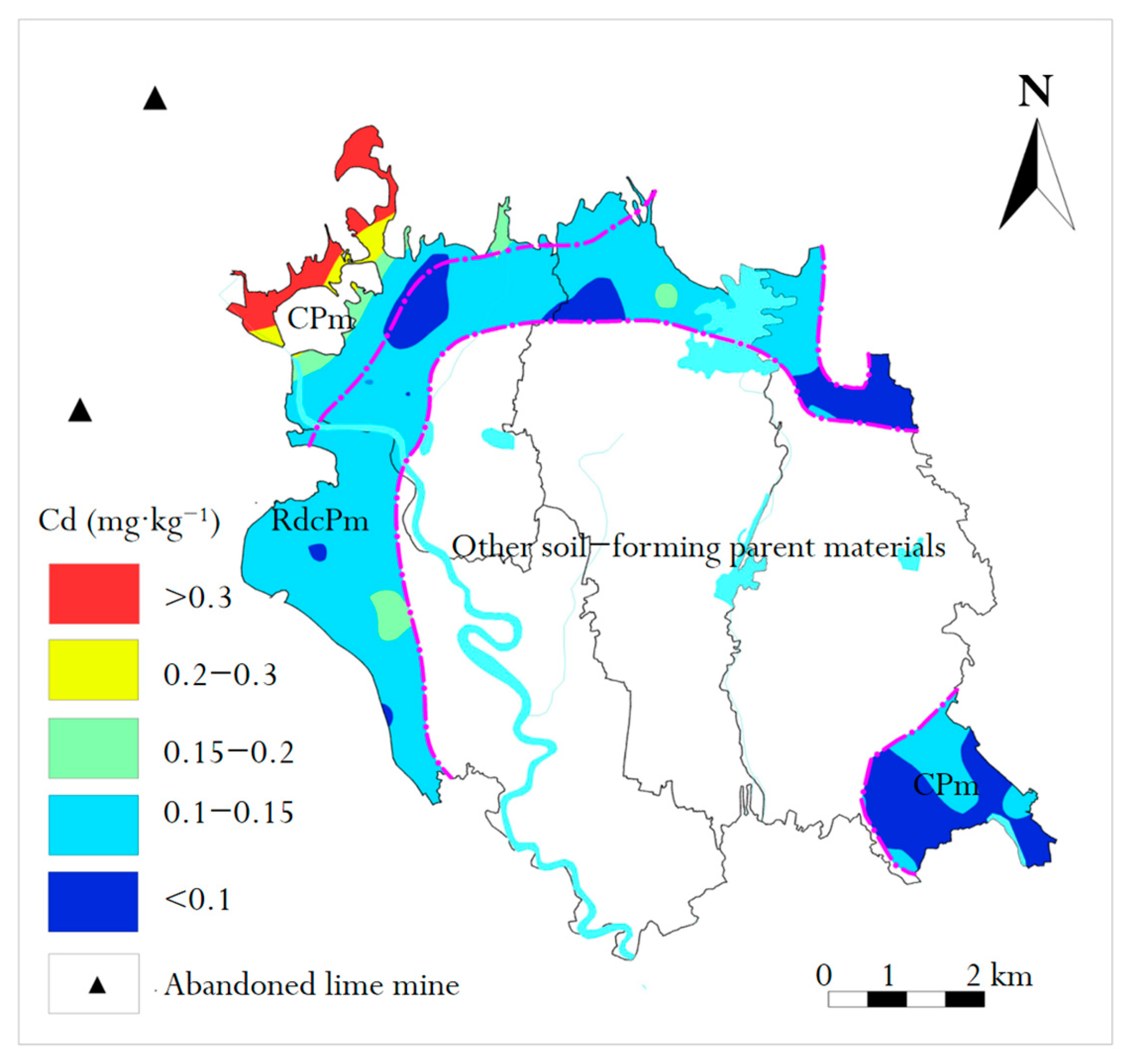
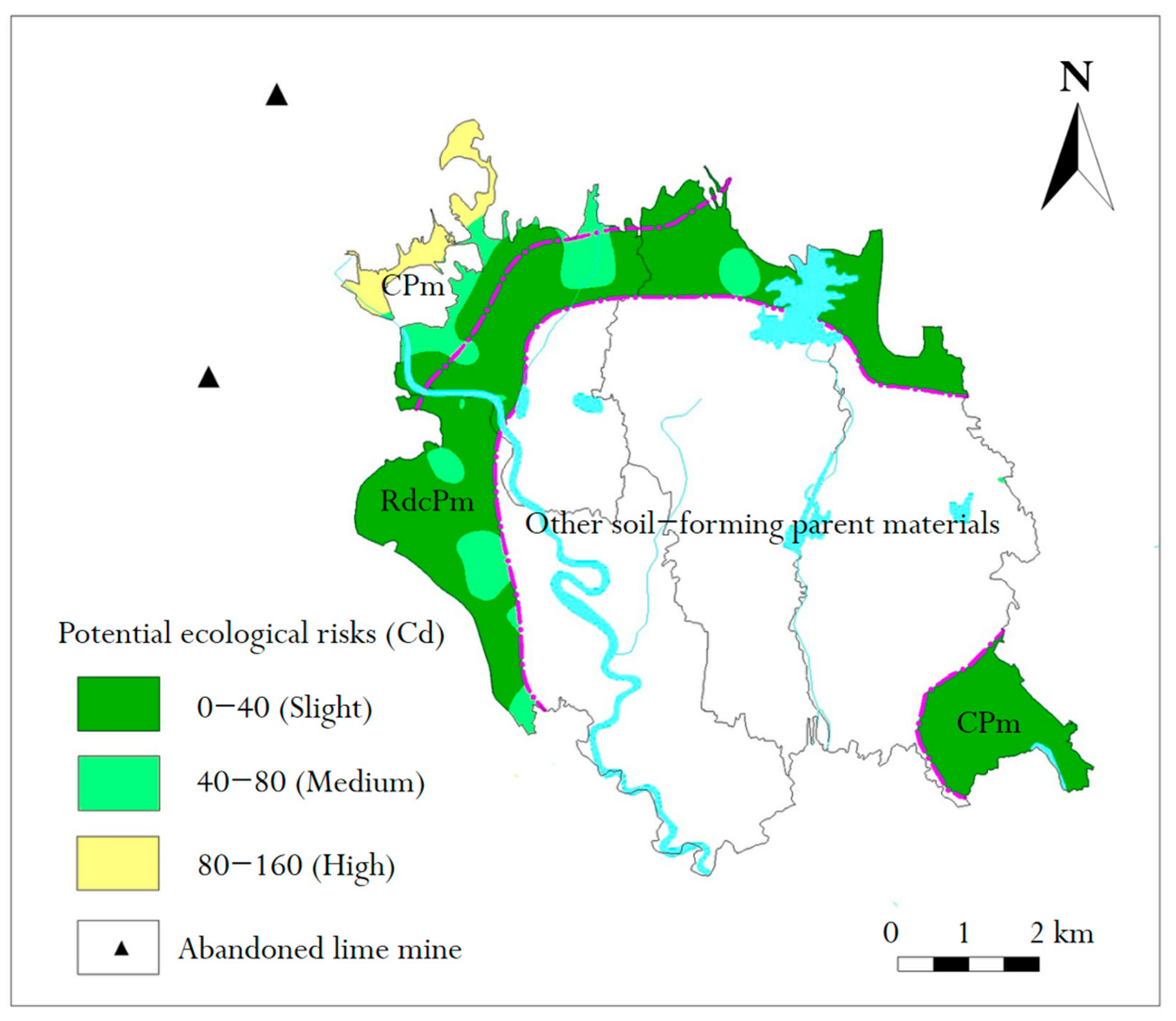
| Soil Types | Number of Statistics | Percentage (%) | |||||
|---|---|---|---|---|---|---|---|
| Montmorillonite | Illite | Kaolinite | Quartz | Calcite | Dolomite | ||
| RdcPm | n = 8 | 21.90 | 31.25 | NA * | 36.27 | 4.75 | 5.83 |
| CPm | n = 6 | NA * | 19.24 | 27.15 | 22.81 | 7.68 | 23.12 |
| Soil Types | Number of Statistics | Percentage (%) | ||||
|---|---|---|---|---|---|---|
| SiO2 | MgO | CaO | MgO + CaO | Other Oxides | ||
| RdcPm | n = 56 | 70.23 | 0.63 | 0.65 | 1.28 | 28.49 |
| CPm | n = 24 | 62.16 | 1.57 | 4.81 | 6.38 | 31.46 |
| Soil Types | Number of Statistics | Cd | SiO2 | MgO | CaO |
|---|---|---|---|---|---|
| RdcPm | n = 56 | 1 | −0.17 | 0.324 | 0.328 * |
| CPm | n = 24 | 1 | −0.549 ** | 0.645 ** | 0.675 ** |
| Soil Types | ||||
|---|---|---|---|---|
| Min | Max | Ave | Std | |
| RdcPm | 16.33 | 69.90 | 32.81 | 9.26 |
| CPm | 16.87 | 206.27 | 43.43 | 32.15 |
Publisher’s Note: MDPI stays neutral with regard to jurisdictional claims in published maps and institutional affiliations. |
© 2021 by the authors. Licensee MDPI, Basel, Switzerland. This article is an open access article distributed under the terms and conditions of the Creative Commons Attribution (CC BY) license (https://creativecommons.org/licenses/by/4.0/).
Share and Cite
Wei, L.; Wang, M.; Liu, G.; Wu, D. Geochemical Anomaly Characteristics of Cd in Soils around Abandoned Lime Mines: Evidence from Multiple Technical Methods. Molecules 2021, 26, 5127. https://doi.org/10.3390/molecules26175127
Wei L, Wang M, Liu G, Wu D. Geochemical Anomaly Characteristics of Cd in Soils around Abandoned Lime Mines: Evidence from Multiple Technical Methods. Molecules. 2021; 26(17):5127. https://doi.org/10.3390/molecules26175127
Chicago/Turabian StyleWei, Lu, Meichen Wang, Guijian Liu, and Dun Wu. 2021. "Geochemical Anomaly Characteristics of Cd in Soils around Abandoned Lime Mines: Evidence from Multiple Technical Methods" Molecules 26, no. 17: 5127. https://doi.org/10.3390/molecules26175127
APA StyleWei, L., Wang, M., Liu, G., & Wu, D. (2021). Geochemical Anomaly Characteristics of Cd in Soils around Abandoned Lime Mines: Evidence from Multiple Technical Methods. Molecules, 26(17), 5127. https://doi.org/10.3390/molecules26175127





